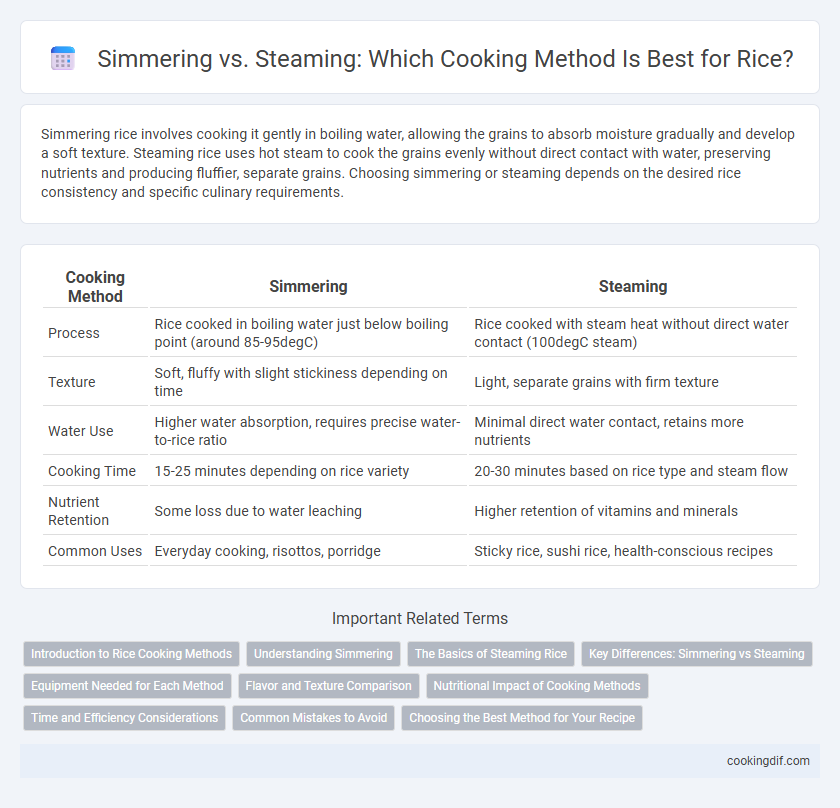Simmering rice involves cooking it gently in boiling water, allowing the grains to absorb moisture gradually and develop a soft texture. Steaming rice uses hot steam to cook the grains evenly without direct contact with water, preserving nutrients and producing fluffier, separate grains. Choosing simmering or steaming depends on the desired rice consistency and specific culinary requirements.
Table of Comparison
| Cooking Method | Simmering | Steaming |
|---|---|---|
| Process | Rice cooked in boiling water just below boiling point (around 85-95degC) | Rice cooked with steam heat without direct water contact (100degC steam) |
| Texture | Soft, fluffy with slight stickiness depending on time | Light, separate grains with firm texture |
| Water Use | Higher water absorption, requires precise water-to-rice ratio | Minimal direct water contact, retains more nutrients |
| Cooking Time | 15-25 minutes depending on rice variety | 20-30 minutes based on rice type and steam flow |
| Nutrient Retention | Some loss due to water leaching | Higher retention of vitamins and minerals |
| Common Uses | Everyday cooking, risottos, porridge | Sticky rice, sushi rice, health-conscious recipes |
Introduction to Rice Cooking Methods
Simmering rice involves cooking grains in a measured amount of water just below boiling point, allowing gradual absorption and softening of the rice. Steaming rice uses indirect heat from boiling water below the grains, preserving texture and enhancing fluffiness by preventing direct water contact. Both methods are essential in rice preparation, with simmering favoring stickier varieties and steaming ideal for long-grain, fluffy results.
Understanding Simmering
Simmering rice involves cooking it in water just below boiling point, typically between 185degF to 205degF (85degC to 96degC), allowing gentle bubbles to evenly cook the grains. This method enables the rice to absorb water gradually, resulting in fluffy texture without sticking or burning. Understanding simmering helps maintain optimal moisture levels and prevents overcooking, ensuring perfectly tender rice every time.
The Basics of Steaming Rice
Steaming rice involves cooking grains with indirect heat from boiling water vapor, preserving nutrients and texture by avoiding direct contact with water. This method results in fluffy, separate grains ideal for delicate dishes, as the steam gently cooks the rice evenly. Proper steaming requires the right ratio of water to rice and using a steamer basket or specialized equipment to maintain consistent temperature and moisture control.
Key Differences: Simmering vs Steaming
Simmering rice involves cooking it in boiling water just below the boiling point, allowing grains to absorb water evenly and develop a tender texture. Steaming rice uses indirect heat from steam to cook grains, preserving nutrients and producing a fluffier, separate-grain result without water saturation. The key differences lie in heat transfer methods--direct water immersion in simmering versus steam exposure in steaming--affecting texture, moisture content, and nutrient retention.
Equipment Needed for Each Method
Simmering rice requires a pot with a tight-fitting lid to maintain consistent heat and trap steam, often paired with a stovetop or cooker. Steaming rice typically involves a steamer basket or specialized rice cooker designed to circulate steam evenly, ensuring fluffy grains without direct water contact. Both methods benefit from equipment that ensures trapped heat and moisture control for optimal rice texture.
Flavor and Texture Comparison
Simmering rice allows grains to absorb water evenly, resulting in a soft, creamy texture with a richer, more infused flavor from added ingredients. Steaming preserves the individual grain integrity, producing a fluffier texture and a cleaner, more distinct rice flavor. Flavor intensity and mouthfeel vary significantly, with simmered rice often offering a more succulent bite compared to the light, airy quality of steamed rice.
Nutritional Impact of Cooking Methods
Simmering rice allows some water-soluble vitamins and minerals to leach into the cooking water, potentially reducing nutrient retention compared to steaming. Steaming preserves more nutrients, such as B vitamins and antioxidants, by using indirect heat and minimal water contact. Research indicates steaming maintains higher levels of essential amino acids and preserves the rice's glycemic index better than simmering.
Time and Efficiency Considerations
Simmering rice typically requires 15 to 25 minutes of cooking time, allowing water to absorb evenly and grains to soften, offering consistent texture but using more energy due to constant heat application. Steaming rice, on the other hand, takes about 20 to 30 minutes and preserves more nutrients by cooking with indirect heat and steam, which enhances efficiency by reducing direct water contact and preventing nutrient leaching. Choosing steaming over simmering can optimize energy use and maintain rice quality, especially when using specialized steamers or rice cookers designed for efficient heat distribution.
Common Mistakes to Avoid
Simmering rice often leads to common mistakes such as using too high heat, which causes uneven cooking and sticky texture, or failing to maintain a consistent simmer, resulting in undercooked or mushy grains. Steaming rice requires avoiding overcrowding the steamer basket and ensuring sufficient water below to prevent drying out or scorching. Proper temperature control and adequate water supply are essential to achieve perfectly cooked, fluffy rice using either method.
Choosing the Best Method for Your Recipe
Simmering rice involves cooking it in a precise amount of water just below boiling, ideal for dishes requiring fluffy, separate grains like pilaf or biryani. Steaming rice uses indirect heat and minimal water, preserving texture and nutrients, making it perfect for sticky or sushi rice varieties. Consider the desired rice texture and recipe requirements when choosing between simmering and steaming to achieve optimal results.
Simmering vs Steaming for cooking process Infographic

 cookingdif.com
cookingdif.com